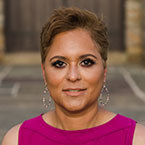By: Jacqueline Dougé, MD, MPH, FAAP &Monique Jindal, MD, FAAP
In light of recent national events, more parents are wondering whether they should talk to their children about race and racism. And, if the answer is yes, how can they do this in a thoughtful and effective manner?
The truth is kids are impacted by race at a very early age.
As early as 3 months, a baby's brain can notice racial differences in the people around them. By age 2, children soak up stereotypes about race and may express these with fear. By age 4, children can directly express bias regarding race by teasing. By age 8, children are aware of social norms and can express bias in more subtle forms. And, by age 12, many children become set in biased thoughts, actions and decisions.
This means that there is nearly a 10-year period where parents may be able to intervene! Parents are the primary sources for children to learn about race and racism. Whether parents choose to talk to their kids about this or not, children will learn from their environments and the other people in their life.
Reflecting on race: look to books
What if we told you that parents can use books to not only help start the conversation, but also keep the conversation going?
Books are powerful tools that can serve as "mirrors, windows, and
maps," reflecting children's own identity. Reading allows children to take a few steps in someone else's shoes, showing children the range of possibilities for their place in the world.
Exposure to diversity: who benefits?
Which children are we talking about? The answer is: all children – Black children, white children, Latinx children, girls, boys, etc. Exposing children to diversity helps children of all
backgrounds. It helps children in to form their own identity and shapes their attitudes and behaviors towards people who are different than them. And while racism is shown to have a significant impact on the
health of children and families, children of all racial/ethnic backgrounds who are exposed to diversity have been shown to be more likely to enroll in college and have higher test scores, self-confidence and leadership skills.
Books can help ensure your child believes in themselves, becomes an ally to others, understands that racism and discrimination exist, recognizes the power of kindness, compassion and empathy for others, and ultimately celebrates both what's common and different among the people they meet.
Strategies to select diverse and inclusive books
Here are some strategies that can help parents select high quality diverse and inclusive books. We recommend choosing books that:
Include characters who share your child's race, ethnicity and your family's cultural and religious beliefs, as well as characters who do not.
Have a main character who is a person of color.
Provide a voice to those who rarely have one.
Tell stories that challenge myths or stereotypes (Hair Love by Matthew A. Cherry, illustrated by Vashti Harrison, about a Black father doing his daughter's hair, for example).
Tell stories that normalize daily life among all racial identities (Corduroy, written and illustrated by Don Freeman, about a Black mother and child going shopping, for example).
Help children develop social action skills (helping the elderly, having environmental awareness, or volunteering at a soup kitchen, for example).
Help children recognize inequities in social structure (consider books about gender and sports or differential treatment of holidays within the United States).
Are written or illustrated by racial/ethnic minorities.
Are age appropriate (picture books for children age 5 and under, and chapter books for elementary aged children).
Present characters facing real-life experiences.
Showcase experiences relevant to their own (The Snowy Day by Ezra Jack Keats, about a Black boy enjoying walking through his neighborhood in the snow, for example).
We also recommend avoiding books that promote stereotypes. such as those that focus on any of the 5 F's (food, fashion, folklore, festivals and famous people). Stereotypes overgeneralize individuals or groups of people. If choosing books on these topics, it is important to reflect on if the book is reinforcing stereotypes and also to select other books that feature this racial or ethnic group in other settings.
How to use books to start conversations about race and racism with your children
The American Psychological Association's (APA) RES Project can help parents learn how to use books to guide conversations. We recommend parents listen and be open to answering their child's questions and use some of the questions on this site as conversation starters. Some examples, by age:
- Preschoolers: "What is different and similar between your child and the characters in the book?"
- Elementary aged children:"Who is your favorite character, and what did you like about them?"
- Preteens and teens:"How did the book inspire you to think differently? How did the book challenge your understanding of race?"
Consider having a family "book club" with teens where parents and teens all read the book and share their reflections and what they learned.
Remember
Talking about race and racism is important. The conversations can start early and be ongoing. Parents are a child's first teacher and our nation's children need us now more than ever. By reading children diverse and inclusive books, we have the opportunity to affirm their own identity, help them learn about others, build empathy and encourage their kindness towards others, all in an effort to build a better and more just world.
More information
About Dr. Dougé
 Jacqueline Dougé, MD, MPH, FAAP is the Child Health Medical Director at the Howard County Health Department. Her interests are health disparities, media, school health and the interaction of public health and pediatrics. Within the American Academy of Pediatrics, she co-chairs the
Council on Community Pediatrics' Prevention and Public Health Special Interest Group. Her blog site is jackiedouge.com.
Jacqueline Dougé, MD, MPH, FAAP is the Child Health Medical Director at the Howard County Health Department. Her interests are health disparities, media, school health and the interaction of public health and pediatrics. Within the American Academy of Pediatrics, she co-chairs the
Council on Community Pediatrics' Prevention and Public Health Special Interest Group. Her blog site is jackiedouge.com.
About Dr. Jindal
 Monique Jindal, MD, FAAP, is a member of the American Academy of Pediatrics (AAP) Section on Minority Healthy, Equity and Inclusion and the Maryland Chapter of the AAP. She is an internal medicine-pediatrics physician at Johns Hopkins Medical Institution. Dr. Jindal's broad research interest is in understanding the impact of racism and discrimination on health equity for minority children and their caregivers. Monique Jindal, MD, FAAP, is a member of the American Academy of Pediatrics (AAP) Section on Minority Healthy, Equity and Inclusion and the Maryland Chapter of the AAP. She is an internal medicine-pediatrics physician at Johns Hopkins Medical Institution. Dr. Jindal's broad research interest is in understanding the impact of racism and discrimination on health equity for minority children and their caregivers.
|